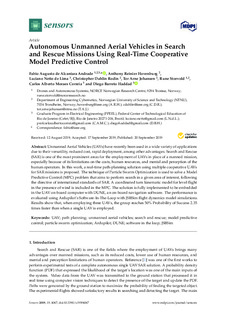| dc.contributor.author | de Alcantara Andrade, Fabio Augusto | |
| dc.contributor.author | Hovenburg, Anthony Reinier | |
| dc.contributor.author | Netto de Lima, Luciano | |
| dc.contributor.author | Dahlin Rodin, Christopher | |
| dc.contributor.author | Johansen, Tor Arne | |
| dc.contributor.author | Storvold, Rune | |
| dc.contributor.author | Moraes Correia, Carlos Alberto | |
| dc.contributor.author | Barreto Haddad, Diego | |
| dc.date.accessioned | 2020-02-10T07:45:17Z | |
| dc.date.available | 2020-02-10T07:45:17Z | |
| dc.date.created | 2019-11-07T13:14:34Z | |
| dc.date.issued | 2019 | |
| dc.identifier.citation | Sensors. 2019, 19:4067 (19), 1-22. | nb_NO |
| dc.identifier.issn | 1424-8220 | |
| dc.identifier.uri | http://hdl.handle.net/11250/2640547 | |
| dc.description.abstract | Unmanned Aerial Vehicles (UAVs) have recently been used in a wide variety of applications due to their versatility, reduced cost, rapid deployment, among other advantages. Search and Rescue (SAR) is one of the most prominent areas for the employment of UAVs in place of a manned mission, especially because of its limitations on the costs, human resources, and mental and perception of the human operators. In this work, a real-time path-planning solution using multiple cooperative UAVs for SAR missions is proposed. The technique of Particle Swarm Optimization is used to solve a Model Predictive Control (MPC) problem that aims to perform search in a given area of interest, following the directive of international standards of SAR. A coordinated turn kinematic model for level flight in the presence of wind is included in the MPC. The solution is fully implemented to be embedded in the UAV on-board computer with DUNE, an on-board navigation software. The performance is evaluated using Ardupilot’s Software-In-The-Loop with JSBSim flight dynamics model simulations. Results show that, when employing three UAVs, the group reaches 50% Probability of Success 2.35 times faster than when a single UAV is employed. | nb_NO |
| dc.language.iso | eng | nb_NO |
| dc.publisher | MDPI | nb_NO |
| dc.rights | Navngivelse 4.0 Internasjonal | * |
| dc.rights.uri | http://creativecommons.org/licenses/by/4.0/deed.no | * |
| dc.title | Autonomous unmanned aerial vehicles in search and rescue missions using real-time cooperative model predictive control | nb_NO |
| dc.type | Journal article | nb_NO |
| dc.type | Peer reviewed | nb_NO |
| dc.description.version | publishedVersion | nb_NO |
| dc.source.pagenumber | 1-22 | nb_NO |
| dc.source.volume | 19:4067 | nb_NO |
| dc.source.journal | Sensors | nb_NO |
| dc.source.issue | 19 | nb_NO |
| dc.identifier.doi | 10.3390/s19194067 | |
| dc.identifier.cristin | 1744937 | |
| dc.relation.project | Norges forskningsråd: 223254 | nb_NO |
| dc.relation.project | EC/H2020/642153 | nb_NO |
| dc.description.localcode | This is an open access article distributed under the Creative Commons Attribution License which permits unrestricted use, distribution, and reproduction in any medium, provided the original work is properly cited | nb_NO |
| cristin.unitcode | 194,63,25,0 | |
| cristin.unitname | Institutt for teknisk kybernetikk | |
| cristin.ispublished | true | |
| cristin.fulltext | original | |
| cristin.qualitycode | 1 | |

